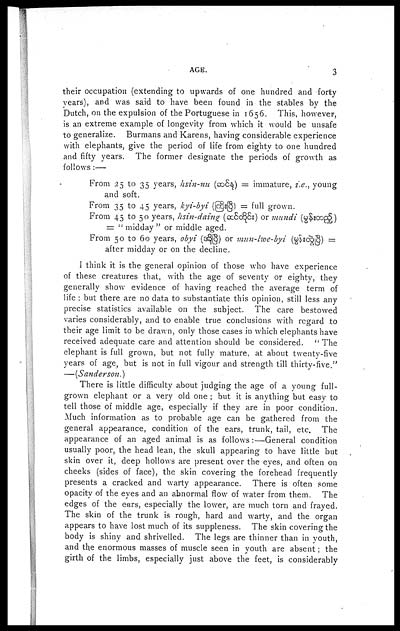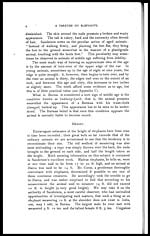Medicine - Veterinary > Veterinary diseases > Elephants and their diseases > Part I - Supply, general hygiene, gear, mounting and restraint
(27) Page 3
Download files
Individual page:
Thumbnail gallery: Grid view | List view

AGE. 3
their occupation (extending to upwards of one hundred and forty
years), and was said to have been found in the stables by the
Dutch, on the expulsion of the Portuguese in 1656. This, however,
is an extreme example of longevity from which it would be unsafe
to generalize. Burmans and Karens, having considerable experience
with elephants, give the period of life from eighty to one hundred
and fifty years. The former designate the periods of growth as
follows :—
From 25 to 35 years, hsin-nu ( ) = immature, i.e., young
and soft.
From 35 to 45 years, kyi-byi ( ) = full grown.
From 45 to 50 years, hsin-daing ( ) or mundi ( )
= "midday" or middle aged.
From 50 to 60 years, obyi ( ) or mun-hve-byi ( ) =
after midday or on the decline.
I think it is the general opinion of those who have experience
of these creatures that, with the age of seventy or eighty, they
generally show evidence of having reached the average term of
life ; but there are no data to substantiate this opinion, still less any
precise statistics available on the subject. The care bestowed
varies considerably, and to enable true conclusions with regard to
their age limit to be drawn, only those cases in which elephants have
received adequate care and attention should be considered. " The
elephant is full grown, but not fully mature, at about twenty-five
years of age, but is not in full vigour and strength till thirty-five."
—[Sanderson.)
There is little difficulty about judging the age of a young full-
grown elephant or a very old one ; but it is anything but easy to
tell those of middle age, especially if they are in poor condition.
Much information as to probable age can be gathered from the
general appearance, condition of the ears, trunk, tail, etc. The
appearance of an aged animal is as follows :—General condition
usually poor, the head lean, the skull appearing to have little but
skin over it, deep hollows are present over the eyes, and often on
cheeks (sides of face), the skin covering the forehead frequently
presents a cracked and warty appearance. There is often some
opacity of the eyes and an abnormal flow of water from them. The
edges of the ears, especially the lower, are much torn and frayed.
The skin of the trunk is rough, hard and warty, and the organ
appears to have lost much of its suppleness. The skin covering the
body is shiny and shrivelled. The legs are thinner than in youth,
and the enormous masses of muscle seen in youth are absent; the
girth of the limbs, especially just above the feet, is considerably
Set display mode to: Large image | Zoom image | Transcription
Images and transcriptions on this page, including medium image downloads, may be used under the Creative Commons Attribution 4.0 International Licence unless otherwise stated. ![]()
| India Papers > Medicine - Veterinary > Veterinary diseases > Elephants and their diseases > Supply, general hygiene, gear, mounting and restraint > (27) Page 3 |
|---|
| Permanent URL | https://digital.nls.uk/75192101 |
|---|




